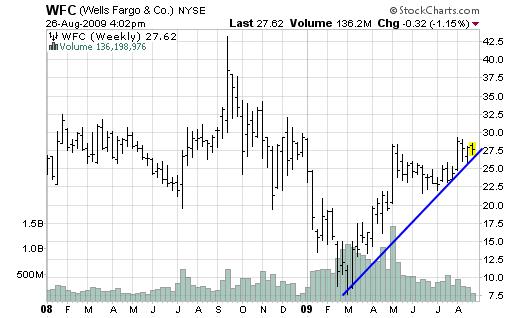 The beating banks took over the last two years was brutal. Failures, bad mortgages, and investments gone bad caused the crisis we just weathered – and it may not be over yet. S&P Sector SPDR Financials (XLF), an ETF that tracks the sector, dropped 72.0% from its high last September to its low in March.
The beating banks took over the last two years was brutal. Failures, bad mortgages, and investments gone bad caused the crisis we just weathered – and it may not be over yet. S&P Sector SPDR Financials (XLF), an ETF that tracks the sector, dropped 72.0% from its high last September to its low in March.
Such painful declines appear to have stopped for now. As we said two weeks ago, financials have friends in high places. Stocks have exploded off the March lows. Banks in general are showing promise as credit becomes easier. There’s still a long way to go for complete recovery, but the trend is pointing up. One bank in particular is exerting itself again as a dominant player: Wells Fargo & Company (WFC).
We like WFC for several reasons. For one, Wells Fargo is positioning itself for the new banking environment. With Citigroup out of the way, WFC is now the third largest bank by market cap. Reports suggest they’re on a hiring binge for their investment and retail banking segments in both San Francisco (their headquarters) and New York. The bank is using government stimulus and market momentum to expand. That’s the right posture for this environment.
Wells Fargo is also skillfully exploiting its physical branch network. These days, people want to shake a banker’s hand and look them in the eye. According to TheStreet.com, WFC has the largest brick-and-mortar banking presence in the country with 10,761 branches. They acquired 3,348 new locations with the recent acquisition of Wachovia. Wells Fargo spokesperson Julia Tunis Bernard played up the merger by saying, “The vast majority of Wachovia’s operations are in markets where we do not have a presence so we complement each other very nicely. That’s the magic of this merger.”
WFC beat earnings expectations for the 2nd quarter and seems poised to meet them for the 3rd quarter. Others have pointed out WFC is at its lowest price/book value since 1994. Since then the stock climbed an annualized 13.6%. Recently WFC shares touched the May highs after breaking intermediate-term resistance. A breakout from this higher trading range is a good bet.
Like most banks, Wells Fargo has non-performing assets on the books. We think this risk is priced into the stock, but it’s still a risk. A class-action lawsuit regarding home equity loans could also prove costly. The market seems to be shrugging off these risks in favor of long-term potential. We like our chances with WFC – at least for the intermediate term.
Ride the wave in financials while you can. To go with one of the big brands in a revitalized banking sector, go with WFC.
